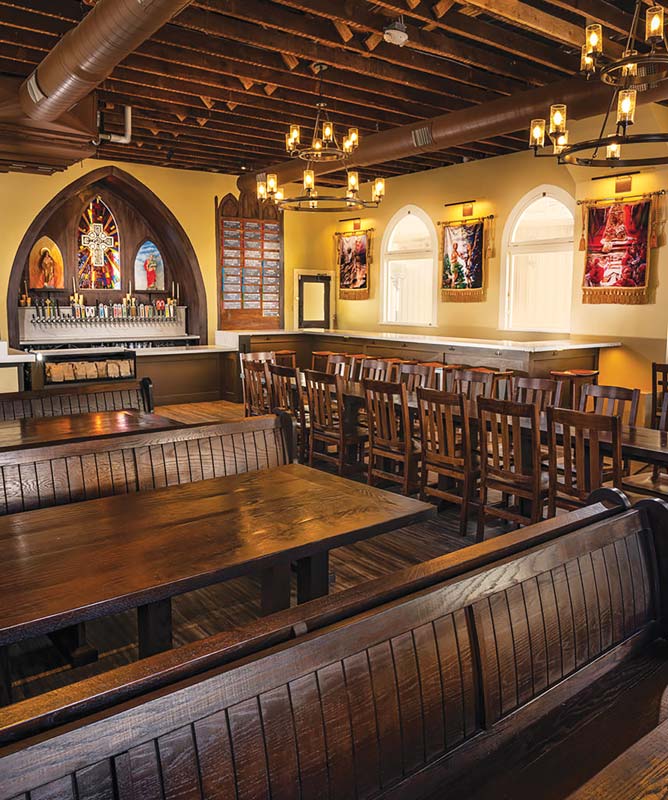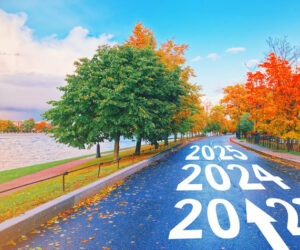Taproom Design
Deliberate layout for optimum success

When it comes to laying out the space of a taproom, you need to always be putting yourself in your customer’s shoes. Walk yourself through the space to feel what they would feel. How do they enter the taproom? What is the first thing they see? Can they get to the bar and order a beer easily? Can they then get out of line and choose a seat easily? What is going to encourage them to make another purchase? There is a lot to consider here.
But before we dive into the details of your taproom design, one of the first things to consider is how much space do you need. Here in the U.S. we still use the Imperial system that measures floor space in square footage. We’ll provide some metric conversions for those of you in the rest of the world. How much space you require depends on how many people you want to accommodate and what type of seating you plan on using. The building code assumes 1 person per 15 square feet (1:15 or 1:1.4 m2) for tables and chairs areas, 1:7 (1:0.7 m2) for chairs only, and 1:5 (1:0.46 m2) for standing area. That is a good starting point. We like to use 1:15 for planning purposes. For example, a 750-square-foot (70 m2) taproom can accommodate approximately 50 people.
Note that if your taproom has an occupant load over 99 persons, fire sprinklers will likely be required per the building code. If your taproom is open to the brewery area, that threshold will be 49 persons. This is calculated based on square footage, not how many people you think you will have in there.
The Grand Entrance
Even before your customers enter the taproom, their experience begins as they approach your site. Signage, landscaping, building materials, and parking all set the mood. Make sure your building is well branded, making it known who you are and what you do. Landscaping and landscape lighting is a great way to frame the building and create visual interest. Make sure you have ample parking for cars and bicycles, easily accessible whether by car, bike, or foot.
A well thought out and properly designed entrance sets the stage for the customer experience.
A well thought out and properly designed entrance sets the stage for the customer experience. It needs to be accessible, meeting all the requirements of the building code, but it is also the portal through which your customer’s experience begins. That sets the mood right from the start.
Interior Aesthetics
Once your customer is in the door, they should know right away they are in a brewery taproom. Not just any taproom, but your taproom. What sets yours apart? Do you have great views of the brewing equipment? Does your taproom aesthetic reflect your brand?
If your taproom is on site with your brewery, it makes great sense to show off all that beautiful stainless steel. You paid for it so show it off. Let your customers know they are where the beer is made. This is where they will get the freshest product possible. Then, represent your brand. Perhaps that is with a feature wall or social media photo space that lets them tell their friends where they are? Color, texture, and lighting can define and reinforce your brand in the taproom, making the experience more relatable and memorable.
Acoustics are also an important part of the customer experience. There are lots of great solutions such as acoustic panels on the ceiling. You can even get acoustic wall panels that can be printed on as art pieces. A low budget idea is to attach carpet remnants to the bottoms of tables and chairs. They help absorb sounds bouncing back up from the floor.
Let’s talk about menu boards. How many times have you walked into a taproom only to discover you can’t read the menu board because the font is too small, or it just takes too long to read through it all to make a decision? A good rule of thumb is 1-in. (2.5-cm) tall lettering for every 10 feet (3 m) of viewing distance. Most beer menus are at least 8 feet (2.4 m) away from the order area. So start with 1-in. (2.5-cm), but don’t go less than ¾-in. (2-cm). Fonts should get larger as patrons line up from the ordering area. Don’t overload your menu board with too much information. All that is needed is the beer name, style, ABV, serving size, price and a few key words to describe the beer, such as the hops used in an IPA. Keep it simple. You can even number your beer list for easy ordering. A paper or QR-code menu can be provided at the door, at the bar, or on a pedestal for more information about each beer.
Digital menu boards can be hard to read. But they can be a great supplement to your main menu by highlighting a particular beer with a photo and more detailed description. It allows you to rotate the offering and help promote a new beer or perhaps one you need to move along.
Time to Cozy In
When it comes to seating, the options are endless. Take into consideration durability and easy to clean materials. There is no sense in saving money on a low-cost chair now only to replace it every year. Hi-tops are bar height tables and can make a space look more full, and gives your patrons a better view of the space. However, they are not ADA (American Disabilities Act) accessible. For that, you will need some low-top options. The building code requires 5% of all seating types, 1 minimum, should be accessible. When providing bar seating, the building code requires a 60-in. (1.5-m) ADA-accessible section. You can get more people into your space with communal tables and drink rails for standing areas. Booths are also a great way to squeeze more seating out of a narrow or corner space. If you are not serving food, consider shallower tables. Think about the experience you want your customers to have. Whatever you do, make sure your customers are comfortable, wanting to stay for another beer.

If you don’t have a separate space for private events, think about how your furniture can be adaptable to accommodate larger parties or special events. Wheeled and or stackable pieces can make that adjustment easier. 2- and 4-top tables can be pushed together for larger groups, but 8-top tables can’t be made smaller.
If you do have an event space, make it adaptable also, perhaps as an overflow space for the taproom when not used for an event. Consider a separate bar, mobile bar, or close proximity to the main bar for easy beer access. Having a restroom near the event space will also reduce traffic in the taproom.
Behind The Bar
The layout of your bar service equipment is important for efficiency. At a minimum, you will need a way to wash glassware, wash hands, and dump a glass. That equipment is best located under the bar to be more out of sight from the customer’s view. Glass washing can be done in a 3-compartment sink. Add a 4th compartment as the dump sink to save space.
A high-temperature glass washer is a great addition to your bar equipment. But, it will break down at some point and inevitably when you most need it. You don’t want to close the taproom for the day just because your glass washer isn’t working. Having a glass washer, in addition to a 3- or 4-compartment sink, will ensure you can keep selling beers even when that glass washer goes down. And, it can help when you get really busy.
Make sure to have a separate dump sink so you are not dumping into your hand or glass washing sinks. A hand sink should never be used for anything other than washing hands. Lay out your bar equipment in a configuration that is best for the workflow of your staff, staging one area for dirty glasses, working them in one direction to the clean area. That way even a new staffer behind the bar knows what is clean and what is dirty. Be sure to leave room under the bar for miscellaneous items such as a trash can, menus, notepads, pens, music systems, etc.

The back bar can be where you store and show off your glassware and perhaps any merchandise you want to feature. A direct-draw draft system, where the beers are served directly from the cold box, is highly encouraged. That is the shortest distance from keg to glass and reduces waste. Leave room for all the taps you want to have, plus a few extra just in case. Consider installing one for CO2 purging, chilled water, cold brew, or any other potential products. If you will have any accessories such as a crowler machine and/or slush machine, leave space for those as well. A drip tray should be 18-in. (45-cm) deep with glass rinsers (carbon filtered and chilled water, of course) and a drain to a floor sink. Put each rinser on a separate shut-off so you can isolate one, just in case. Consider a separate, self-service water station for your guests so they don’t take time away from your servers. You make good beer, so you should be serving good water too.
Brand Awareness
Profits from merchandise should not be overlooked. They can be a huge part of your business. Long gone are the days of pinning a t-shirt on the cold box. Leave space for a dedicated merchandise area. Cubbies are a great way to show off different items while allowing for some storage space. Let your customers interact with your merchandise. Sales increase dramatically when a customer is allowed to touch and feel a product. Don’t forget your to-go beer. Make it visible and easily accessible, so your guest can take home a few extra beers to share with friends and spread the word. There is no better marketing than word of mouth by a satisfied customer.
Final Notes
Don’t skimp on your restrooms. These are intimate spaces that should not be neglected. Wall tile is an inexpensive way to have a clean, washable surface, and add some color and flare to your restrooms. Take it 54-in. (1.4-m) high and do something interesting above that, maybe with a custom-printed wall covering or mural. Light fixtures can also be used to dramatic effect. Restrooms are small, so it does not take a lot to make them nice and memorable. While you have their attention, this is also a marketing opportunity. Art frames are great ways to mention upcoming events or feature a new beer or merchandise you want to sell. Also, make it barrier free/automated to reduce physical contact with surfaces. Motion sensing fixtures can save money on water usage and supplies. Create a restroom experience they will go back to their table and tell their friends about.
The taproom experience begins before your guests even enter the building. Take everything into consideration from the entrance, line queuing, ordering, seating, merchandise, and even the restrooms. Your taproom defines your brand and is your best revenue producer. Create an inviting, comfortable environment where your customers can enjoy your delicious beer and want to keep coming back time and time again. That is the recipe to success.


